Warning: pic heavy, as usual. 
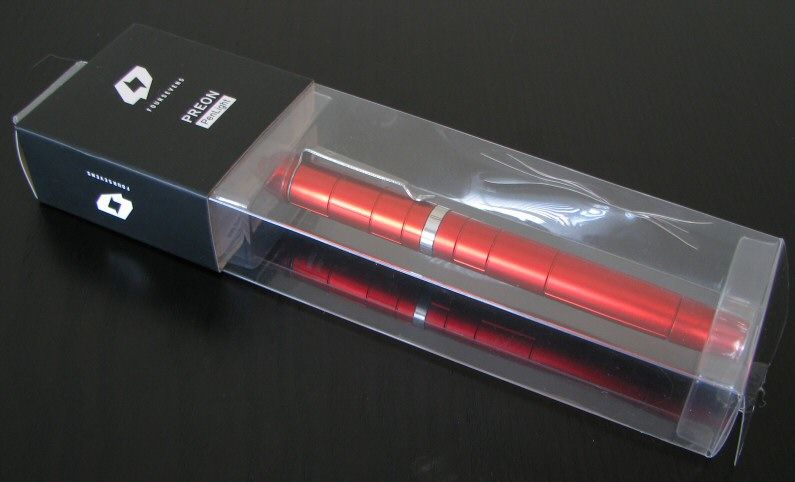
Welcome to the new 2xAAA Preon Penlight from Foursevens. This new model is in addition to the earlier Preon P2, which I have previously reviewed in early 2010, and with a revised emitter in late 2011.
The new penlight looks and feels more like a traditional pen. Let's see how it stacks up to the earlier model and competition. :wave:
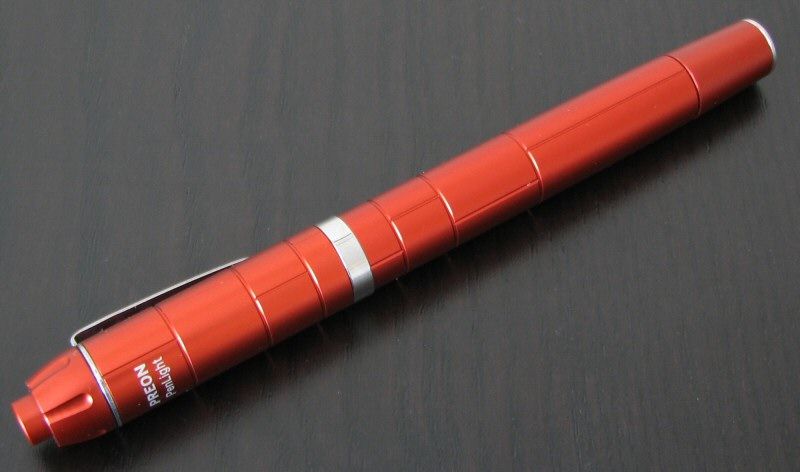
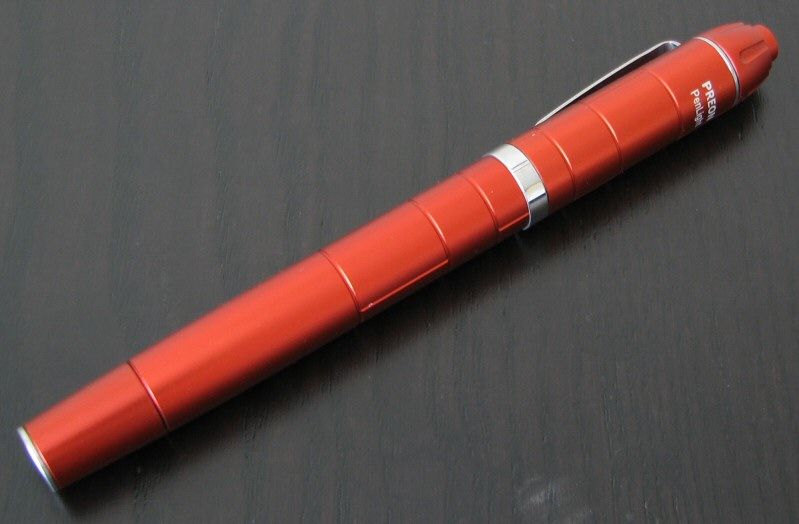
As a side note, this same penlight has also been released under Olight's own name (as the O'Pen). Some additional specs for NiMH output/runtime are provided below.
Manufacturer Reported Specifications:
(note: as always, these are simply what the manufacturer provides – scroll down to see my actual testing results).
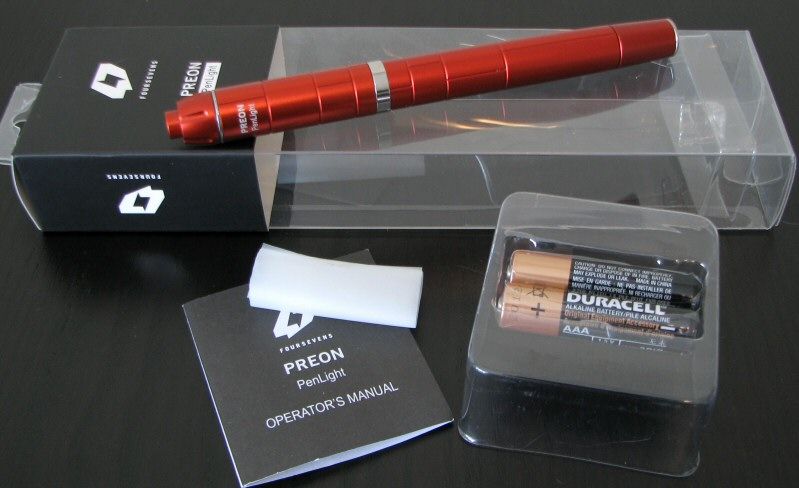
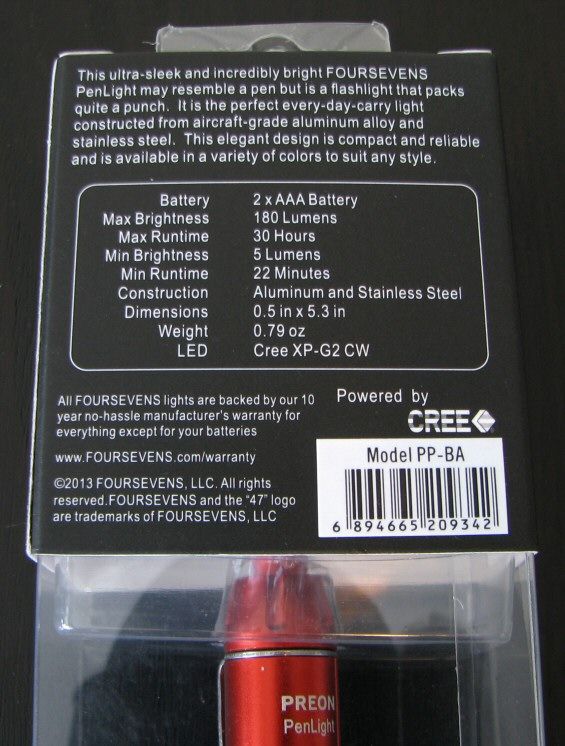
The new Preon Penlight comes in a new style of packaging, which is more stylish and shows off the product more explicitly. Inside the clear plastic container is the light, extra o-ring, a pair of Duracell AAA alkaline batteries and a manual. There is also an overview of specs on the back of the packaging.
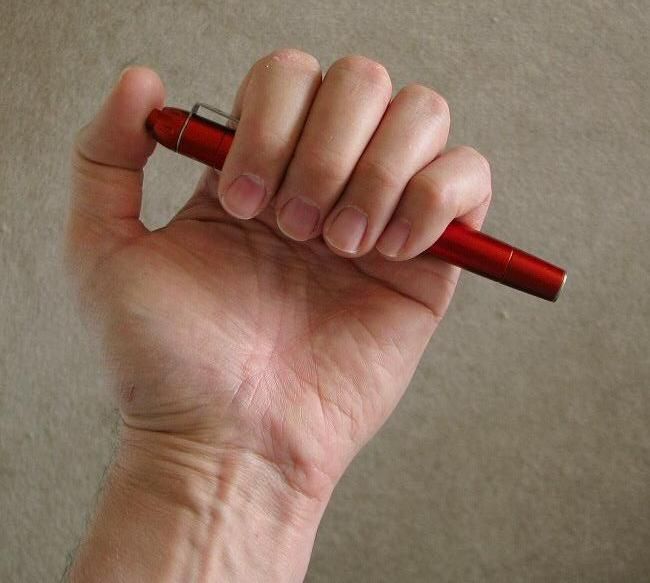
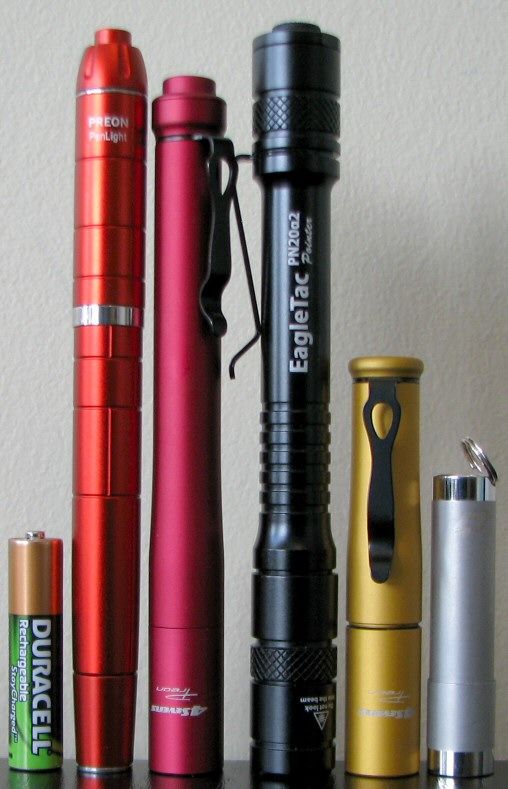
From left to right: Duracell AAA; Foursevens Preon Penlight, Preon P2; Eagletac PN20a2; Foursevens Preon P1, P0.
2xAAA:
Foursevens Preon Penlight: Weight 21.9g, Length 136.9mm, Width (bezel) 11.0mm, Width (cap) 13.5mm
Foursevens Preon P2: Weight 20.2g (with keychain clip), Length 127.4mm, Width (bezel) 14.0mm
Eagletac PN20α2: Weight 31.3g (with pocket clip), Length 137.7mm, Width (bezel) 16.0mm
1xAAA:
4Sevens Preon P0: Weight 13.0g (with keychain clip), Length 55.0mm, Width 12.6mm (bezel)
4Sevens Preon P1: Weight 15.3g (with keychain clip), Length 75.6mm, Width 14.0mm (bezel)
Olight i3: Weight 13.2g, Length: 71.9mm, Width (bezel): 14.0mm
Illuminati Aluminum: Weight 13.9g (with keychain clip), Length 68.8mm, Width 14.0mm (bezel)
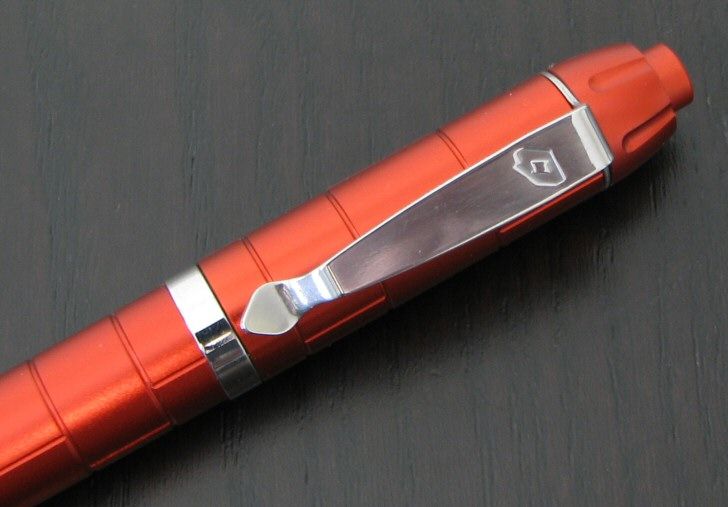
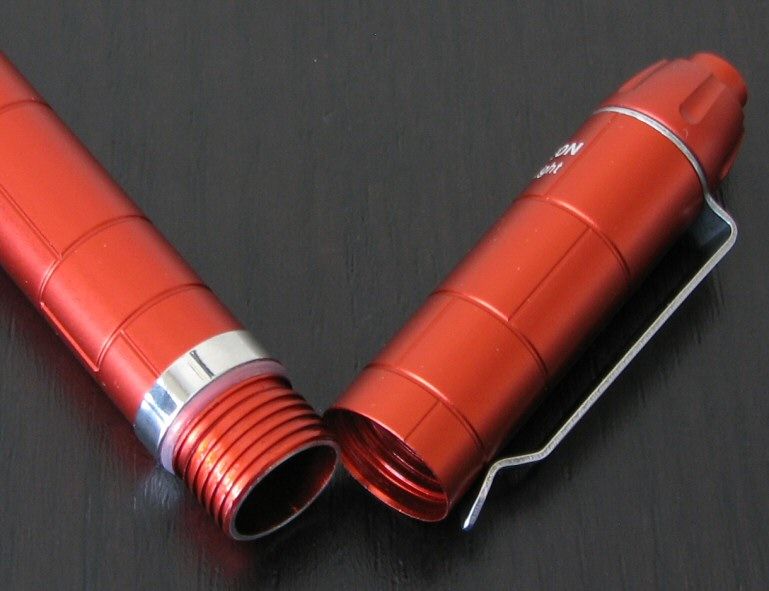
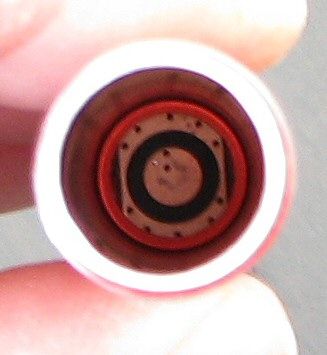
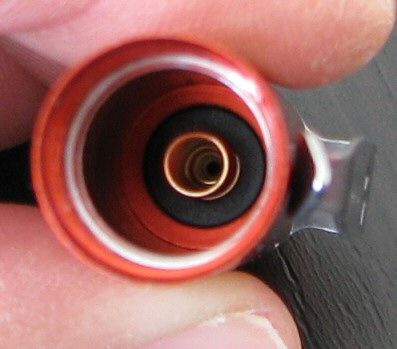
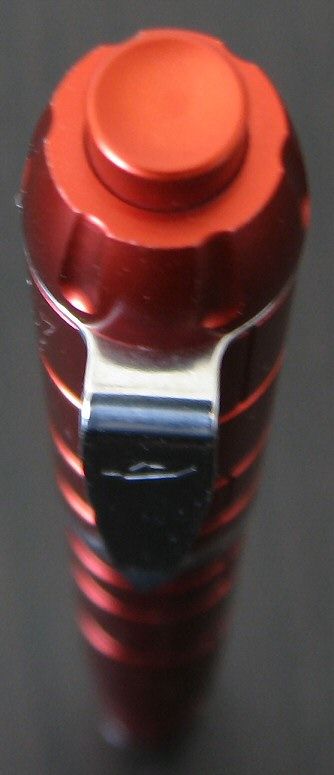
The Preon Penlight is definitely larger than the earlier P2. I also find it looks a lot more like an actual pen. The construction feels very solid. Grip is decent - thanks to the engraved groove design – but may still be a bit smooth for some. Pocket clip is fairly basic, but holds well enough in my limited testing. It also helps with grip, and serves as an anti-roll device.
Note that a new batch of anodizing colours has been developed for the Penlight series ("Burnt Orange" for the sample they sent me). The anodizing was flawless on my sample.
The anodizing was flawless on my sample.
Screw threads are surprisingly good on the Penlight. One thing I noticed on the earlier Preon P1/P2 (and P0) was very fine threads, leading to a potential concern of cross-threading risk. But like the rest of the light, the Penlight threads have a solid feel, thicker than most and cut fairly deeply. They are in fact square-cut (trapezoidal), which is impressive on a light this size. oo: They are also anodized for lock-out, which gives you the option to change modes by a twist instead of click (scroll down for the user interface).
oo: They are also anodized for lock-out, which gives you the option to change modes by a twist instead of click (scroll down for the user interface).
The Penlight has a reverse clicky switch in the "tail" of the light. This means you have to press and release for the switch to turn on. Switch feel is about typical for the class. Note that I found the original Preon P2 to be a bit "squishy" for my tastes.
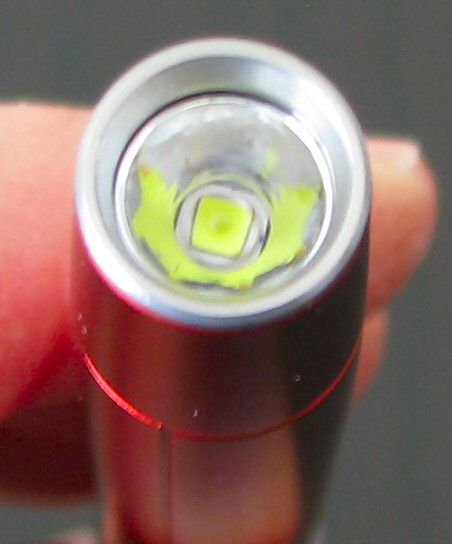
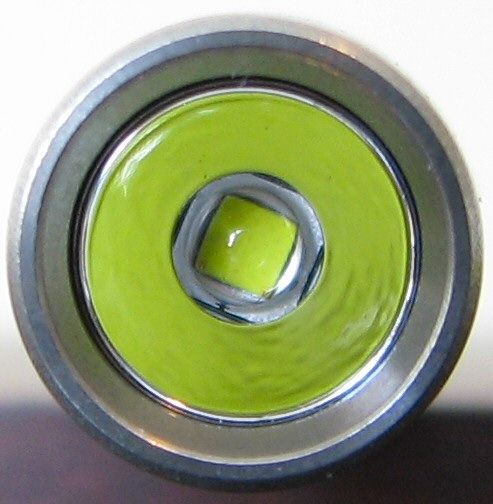
The Penlight uses a very small reflector, as the light is tapered at the head. A new style XP-G2 emitter (cool white on my sample, I don't know if Foursevens plans to release other tints) was well centered. Given the size of the head and emitter choice, I would expect a broader hotspot than the earlier XP-E-based Preon P2s. You should have a relatively floody beam here.
The head of the light was sealed on my sample (presumed Loctite), but you may be able to force it open with strap wrenches.
User Interface
The Penlight is very straightforward – gone are the "hidden" modes of the Preon P2.
Turn the light on by clicking the reverse clicky tailswitch (press and release). The light will come on in the last memorized output mode. You can then cycle through modes by repeatedly clicking the switch off/on. Mode sequence is Lo > Med > Hi, in repeating loop upon successive click.
Light has mode memory, and retains the last level set (this is a departure from the P2, which always came on in Lo). Also gone are all the "hidden" extra modes of the P1/P2 series – you just have the three regular output modes now.
Note that the light can also operate as a twisty to change modes, as long as the switch is in the clicked On postion.
Video:
For information on the light, including the build and user interface, please see my video overview:
Video was recorded in 720p, but YouTube typically defaults to 360p. Once the video is running, you can click on the configuration settings icon and select the higher 480p to 720p options. You can also run full-screen.
As with all my videos, I recommend you have annotations turned on. I commonly update the commentary with additional information or clarifications before publicly releasing the video.
PWM/Strobe
Another departure from the P1/P2 – the Penlight appears to be current controlled. I can detect no sign of PWM at any level.
Similarly, there is no strobe mode either.
Beamshots:
All lights are on Sanyo Eneloop AAA NiMH, about ~0.75 meter from a white wall (with the camera ~1.25 meters back from the wall). Automatic white balance on the camera, to minimize tint differences.
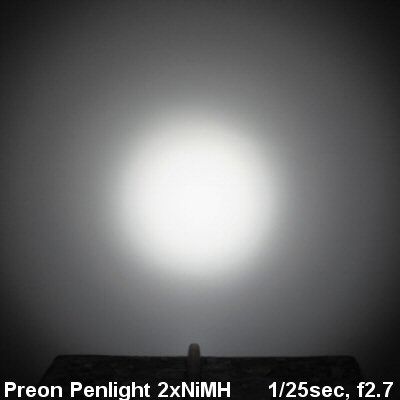
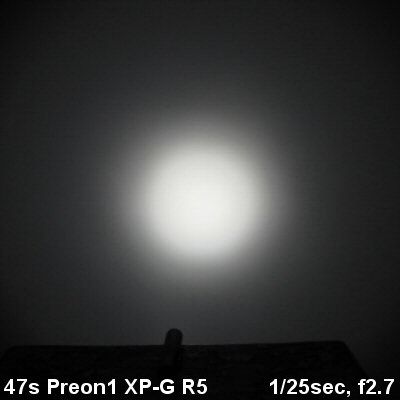
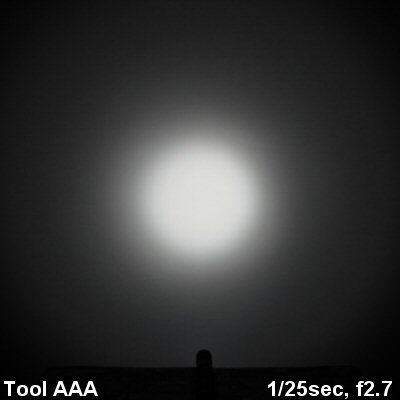
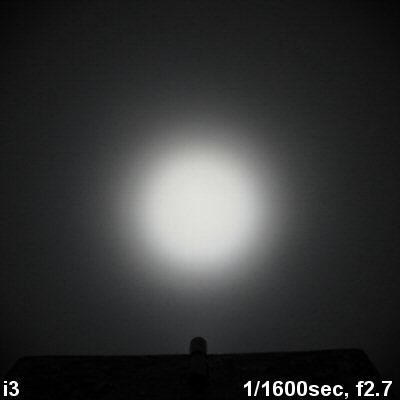
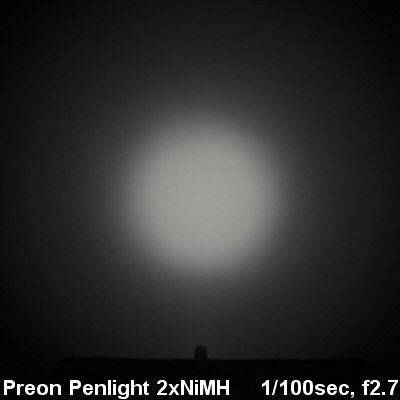
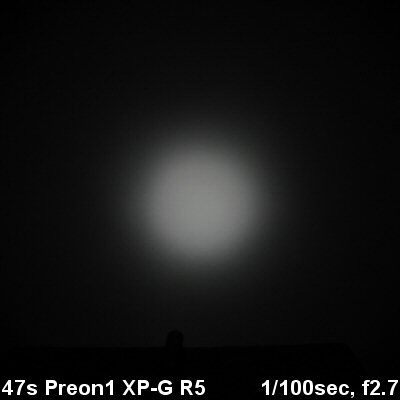
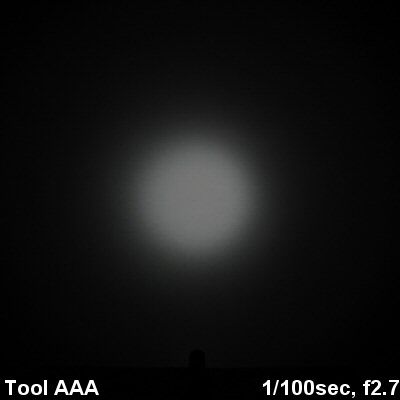
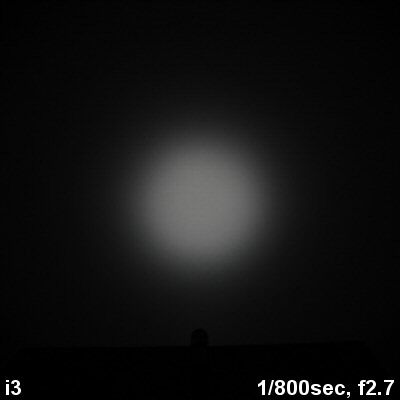
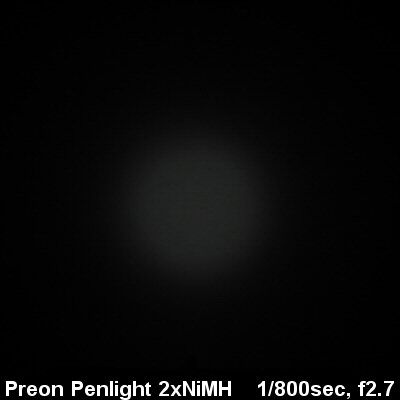
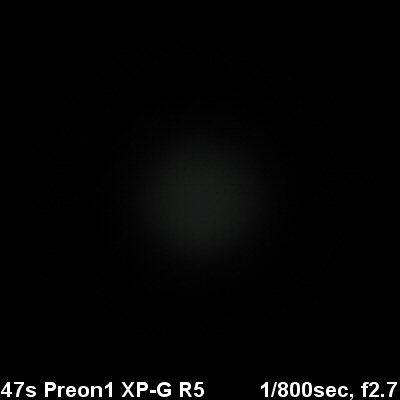
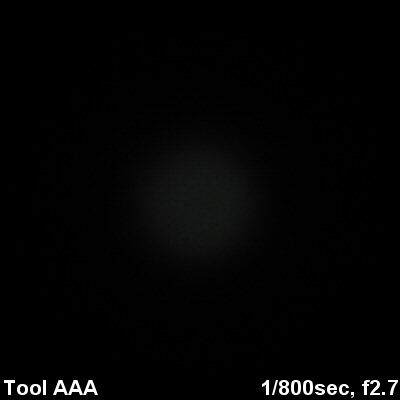
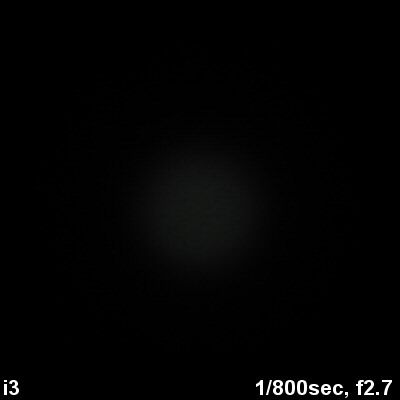
Sorry, I haven't had a chance to do additional beamshots of my other 2xAAA lights. I will add those in the coming days.
But the above comparisons do give you the idea that the hotspot on the Penlight is broader than typical 1xAAA lights. Overall spillbeam width is not really any different, compared to the other lights (although the brightness of spill seems to be proportionately higher).
Again, I'll be able to say more once I add the other 2xAAA lights. Stay tuned …
Testing Method:
All my output numbers are relative for my home-made light box setup, as described on my flashlightreviews.ca website. You can directly compare all my relative output values from different reviews - i.e. an output value of "10" in one graph is the same as "10" in another. All runtimes are done under a cooling fan, except for any extended run Lo/Min modes (i.e. >12 hours) which are done without cooling.
I have devised a method for converting my lightbox relative output values (ROV) to estimated Lumens. See my How to convert Selfbuilt's Lightbox values to Lumens thread for more info.
Throw/Output Summary Chart:
My summary tables are reported in a manner consistent with the ANSI FL-1 standard for flashlight testing. Please see http://www.flashlightreviews.ca/FL1.htm for a discussion, and a description of all the terms used in these tables. Effective July 2012, I have updated all my Peak Intensity/Beam Distance measures with a NIST-certified Extech EA31 lightmeter (orange highlights).
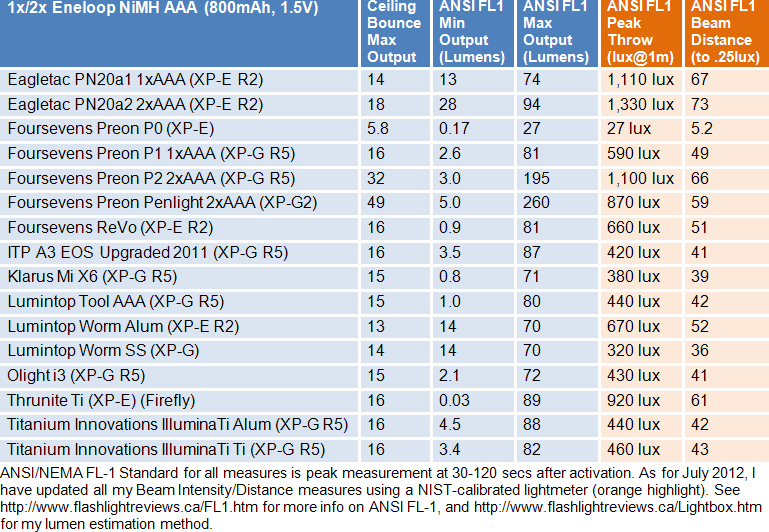
As usual in my recent testing, my estimated output measures are higher than the Foursevens specs. Keep in mind that my estimation method is based on a calibration of my lightbox to certain specific makers and testers (including Foursevens), from a specific point in time (see my Lumen Estimation page for more information). But the key point has always been that it doesn't matter for relative output measures, as those remain consistent across all my reviews (i.e., regardless of the absolute value of the calibration, the relative relationships in the table above always hold consistently).
As a result of the above, I have always recommended you don't focus on one arbitrary output time point (i.e., ANSI FL-1 30 secs), but rather look at the full runtime graphs for how relative output changes over time. The Preon Penlight really underscores this need, for two reasons – as my runtimes below will show, there is a difference in initial output between battery types, and a rapid change in output on some modes.
Note as well that Foursevens doesn't specify in any of the packaging materials how or when the lumen output is measured, or on what type of cells (i.e., they only state "out the front" lumens). However, the Olight O'Pen (which is the identical model, released under Olight's name) provides comparable lumen and runtime estimates for alkaline cells, as well as additional specs for NiMH. To give you a better idea of what is going on, here is a summary table with my estimated lumen output levels at two time points – ANSI FL-1 standard of 30 secs post-activation, and 5 mins post-activation - on alkaline and NiMH Eneloop.
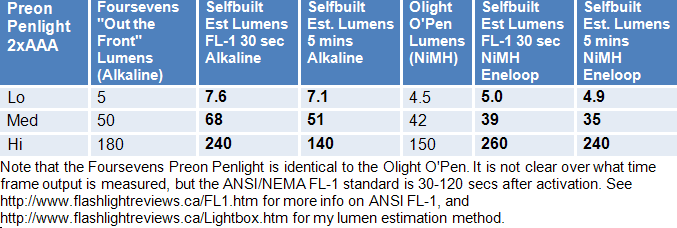
As you will see, overall output levels are lower on NiMH across the board. But as you will also see, the output for a given level can change fairly significantly over the first few mins as well. I have no information as to when exactly Foursevens determined their "out the front" lumens (e.g., there is no mention of ANSI FL-1 anywhere on the documentation).
Given the above, it is critical that you examine the actual runtime curves, to find out when exactly a given mode reaches its "steady-state" flat regulation level. You cannot necessarily rely on a simple table of a single time point to tell you everything you need to know.
Output/Runtime Comparison:
Note: As always, my runtime graphs are presented in my relative lightbox output scale, NOT in estimated lumens.
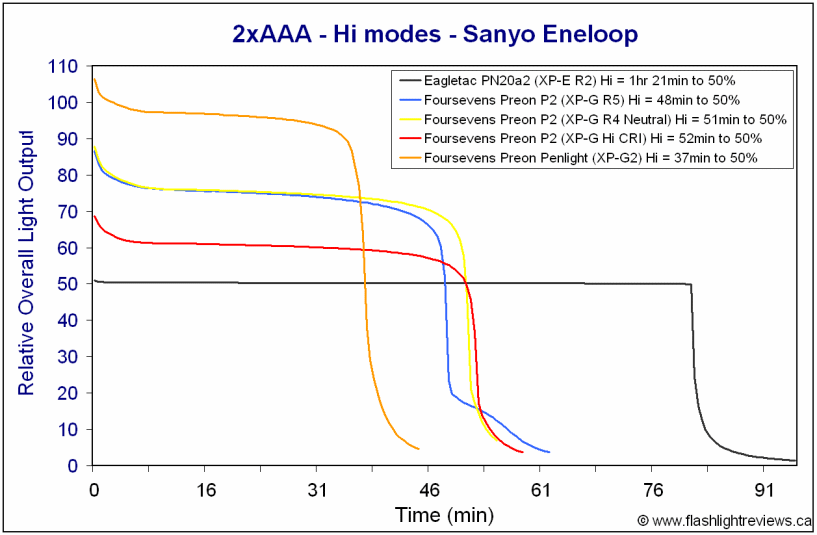
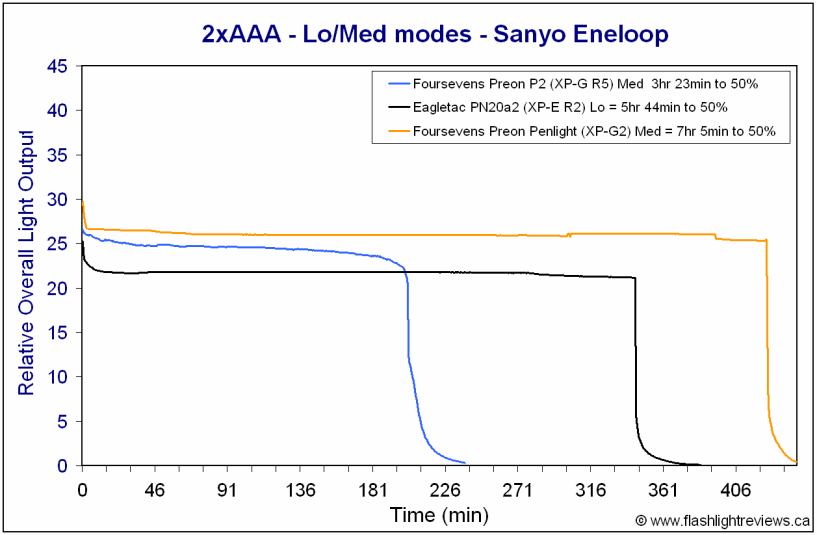
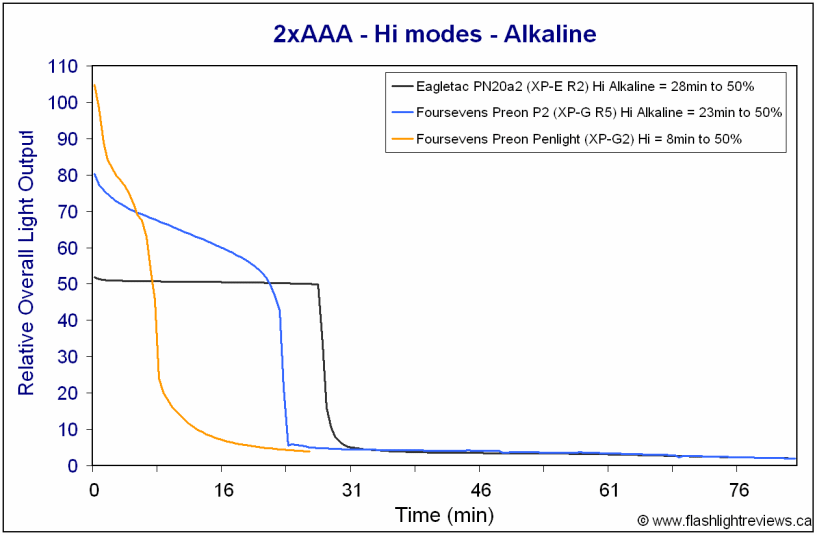
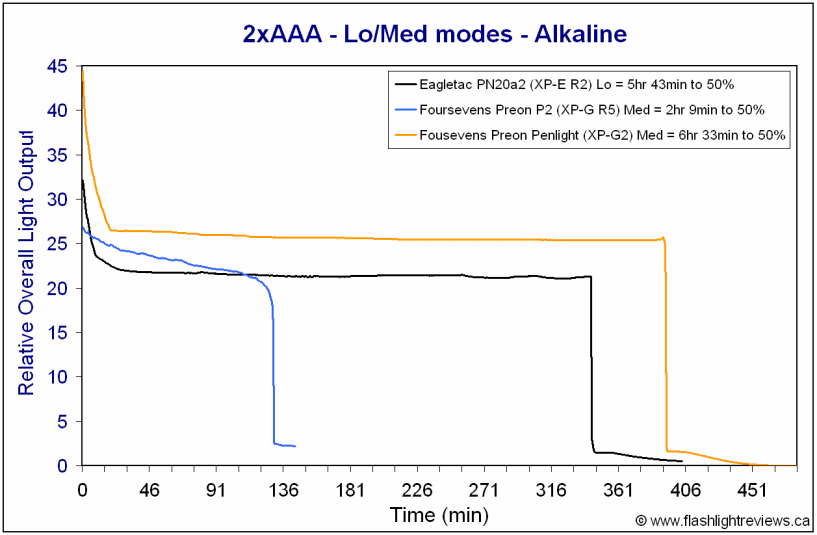
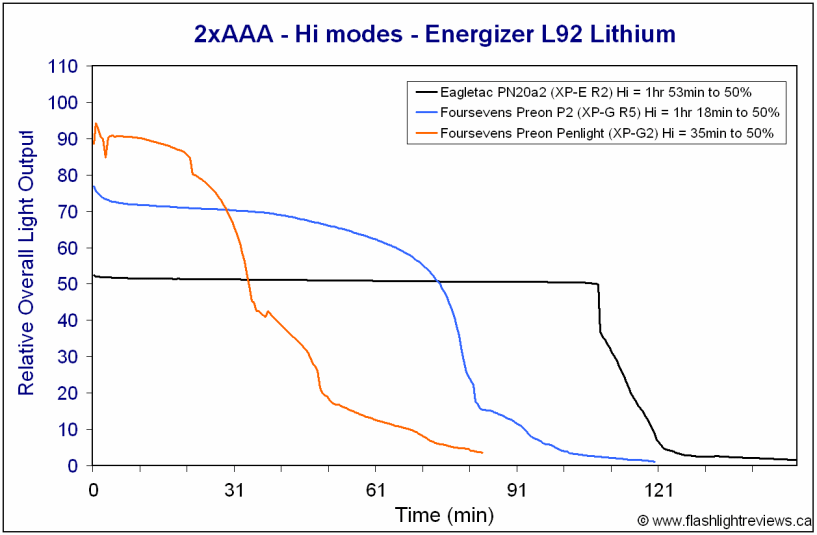
The above runtimes provide a lot more information about relative output level changes over time. I suggest you go through them carefully, to get a better feel for how output differs between battery types, and over time. But keep in mind the above graphs are in my raw relative lightbox output values, not estimated lumens.
In addition to my earlier comments, a few other immediate observations strike me from the runtimes above. The first of these is that the new current-controlled circuit on the Penlight is a lot more efficient at the Med level than the earlier Preon P2 (and presumably, at the Lo as well). :thumbsup:
The second point is that the Penlight is driven higher on Max than the earlier P2. While some may like this extra boost, it does lower relative efficiency. It causes a particular issue for alkaline cells, which are not designed for these sorts of drain rates (i.e., output drops rapidly). Although oddly, L92 also seems to underperform what I would have expected. The take home message from the above is that on Hi, the Penlight is best suited to NiMH rechargeable cells.
But to come back my earlier point on output levels, the results above make it clear that initial activation is higher at all levels than the steady-state flat-regulation level (except for perhaps L92 lithium). At a minimum, I would suggest you consider both initial activation, and a period 5+ mins after activation (when most modes have stabilized).
In terms of the runtime specs, there is again no mention of use of the ANSI FL-1 standards (which is time to 10% of peak output post 30 secs). However, using this standard, my NiMH results correlate fairly well with the reported runtimes. Alkaline runtime specs seem over-stated for my sample however, as I observed reduced runtimes compared to what they report. For example, I found 0.15 hours on Hi measured for Duracell alkaline (ANSI FL-1) on my sample, compared to the 0.4 hours Foursevens spec. Similarly, on Med, I found 6.5 hours on Duracell alkaline (ANSI FL-1), compared to 8 hours spec. But again, you need to put that in context of other lights at these output levels - the Penlight is certainly a very efficient model (at least on Med). And it's possible my sample is driven higher on Hi than typical (i.e., I don't know how variable output/runtimes are across samples).
Potential Issues
The Penlight is highly driven on Hi, leading to relatively short runtimes on alkaline or L92 lithium (compared to others in this class). I found the head gets very warm very quickly on Hi, so I don't imagine you will want to run the light for extended periods at that level.
The Penlight is larger than the earlier Preon P2, but has a more traditional pen size and design.
Output level estimation is complicated by the differing initial output levels on alkaline and NiMH (compared to the steady-state regulated level, which was often lower). See the runtime graphs above for more information.
Runtimes seem fairly accurate on NiMH (for the ANSI FL-1 standard to 10%), but seem optimistic on alkaline (at least based on my one sample).
Preliminary Observations
The Penlight is a solid, well-built 2xAAA light. It has a more substantial look and feel compared to the earlier Preon P2. In terms of build and hand feel (including switch feel), I would consider the Penlight to be a superior light.
Styling is always going to be a matter of personal preference, but I find the build elements work well together. The clip is serviceable (although we'll see how it holds up to long term use/abuse), and I like the grooved body design. Batteries (including NiMH) fit well, with little evidence of rattle on my sample.
Personally, I am quite happy with the new limited 3-mode interface. I have never seen the need for a tactical strobe mode in a penlight. I also like the new mode memory feature - with the light starting on Lo when cycling through levels, but retaining the last setting for re-activation.
I also like the new mode memory feature - with the light starting on Lo when cycling through levels, but retaining the last setting for re-activation.
Output/runtime performance is generally excellent for the output level and battery source. I am glad to see Foursevens was able to incorporate a current-controlled circuit in this relatively small head (i.e., no PWM flicker or reduced efficiency). :thumbsup:
The only issue I have here is the output level on Hi seems excessive, resulting in both higher heat and lower runtime (especially on standard alkaline cells). I would suggest you use the Hi mode for brief periods of time only. I'd recommend to the manufacturer a lower Hi mode, but otherwise I think the level spacing is appropriate for a general purpose light (although a moonlight mode would also have been nice).
In terms of the beam, the Preon Penlight has a relatively broad hotspot. Overall spillbeam width is not particularly wide, but the spill is relatively bright. Coupled with the broad hotspot, this gives it a fairly even or "floody" appearance. I think this beam pattern is well suited to a penlight (i.e., I don't like a tight hotspot in this form factor). The XP-G2 emitter appears to have been a good choice for the build.
I don't know what Foursevens plans are for the original Preon P2, but I can see the Penlight fitting into a more "presentation-style" general-purpose niche. Note that it is also available as the Olight O'Pen. Certainly another option to consider in the 2xAAA space - and a classy looking one at that. :wave:
----
Preon Penlight was supplied by Foursevens for review.

Welcome to the new 2xAAA Preon Penlight from Foursevens. This new model is in addition to the earlier Preon P2, which I have previously reviewed in early 2010, and with a revised emitter in late 2011.
The new penlight looks and feels more like a traditional pen. Let's see how it stacks up to the earlier model and competition. :wave:


As a side note, this same penlight has also been released under Olight's own name (as the O'Pen). Some additional specs for NiMH output/runtime are provided below.
Manufacturer Reported Specifications:
(note: as always, these are simply what the manufacturer provides – scroll down to see my actual testing results).
- LED Emitter: CREE XP-G2
- Voltage range: 0.9V-3V
- Spot Beam: Angle: 25 Degree
- Flood Beam: Angle: 74 Degree
- Brightness Levels (Alkaline presumed): Low: 5 lumens, 30 hrs/ Medium: 50 lumens, 8 hrs/ High: 180 lumens, 0.4 hrs
- Olight O'Pen Brightness Levels (NiMH): Low: 4.5 lumens, 30 hrs/ Medium: 42 lumens, 7.5 hrs/ High: 150 lumens, 0.7 hrs
- Reflector: Textured
- Body/Bezel Material: Type-III hard-anodized aircraft-grade aluminum
- Lens Material: Hardened tempered glass lens with antireflective coating on both sides
- Dimensions: Length: 5.3 inches/Body diameter: 0.5 inches/Head diameter: 0.5 inches
- Weight (without batteries): 0.79 oz
- Included Accessories: Batteries
- MSRP: ~$50-60


The new Preon Penlight comes in a new style of packaging, which is more stylish and shows off the product more explicitly. Inside the clear plastic container is the light, extra o-ring, a pair of Duracell AAA alkaline batteries and a manual. There is also an overview of specs on the back of the packaging.


From left to right: Duracell AAA; Foursevens Preon Penlight, Preon P2; Eagletac PN20a2; Foursevens Preon P1, P0.
2xAAA:
Foursevens Preon Penlight: Weight 21.9g, Length 136.9mm, Width (bezel) 11.0mm, Width (cap) 13.5mm
Foursevens Preon P2: Weight 20.2g (with keychain clip), Length 127.4mm, Width (bezel) 14.0mm
Eagletac PN20α2: Weight 31.3g (with pocket clip), Length 137.7mm, Width (bezel) 16.0mm
1xAAA:
4Sevens Preon P0: Weight 13.0g (with keychain clip), Length 55.0mm, Width 12.6mm (bezel)
4Sevens Preon P1: Weight 15.3g (with keychain clip), Length 75.6mm, Width 14.0mm (bezel)
Olight i3: Weight 13.2g, Length: 71.9mm, Width (bezel): 14.0mm
Illuminati Aluminum: Weight 13.9g (with keychain clip), Length 68.8mm, Width 14.0mm (bezel)





The Preon Penlight is definitely larger than the earlier P2. I also find it looks a lot more like an actual pen. The construction feels very solid. Grip is decent - thanks to the engraved groove design – but may still be a bit smooth for some. Pocket clip is fairly basic, but holds well enough in my limited testing. It also helps with grip, and serves as an anti-roll device.
Note that a new batch of anodizing colours has been developed for the Penlight series ("Burnt Orange" for the sample they sent me).
Screw threads are surprisingly good on the Penlight. One thing I noticed on the earlier Preon P1/P2 (and P0) was very fine threads, leading to a potential concern of cross-threading risk. But like the rest of the light, the Penlight threads have a solid feel, thicker than most and cut fairly deeply. They are in fact square-cut (trapezoidal), which is impressive on a light this size.
The Penlight has a reverse clicky switch in the "tail" of the light. This means you have to press and release for the switch to turn on. Switch feel is about typical for the class. Note that I found the original Preon P2 to be a bit "squishy" for my tastes.


The Penlight uses a very small reflector, as the light is tapered at the head. A new style XP-G2 emitter (cool white on my sample, I don't know if Foursevens plans to release other tints) was well centered. Given the size of the head and emitter choice, I would expect a broader hotspot than the earlier XP-E-based Preon P2s. You should have a relatively floody beam here.
The head of the light was sealed on my sample (presumed Loctite), but you may be able to force it open with strap wrenches.
User Interface
The Penlight is very straightforward – gone are the "hidden" modes of the Preon P2.
Turn the light on by clicking the reverse clicky tailswitch (press and release). The light will come on in the last memorized output mode. You can then cycle through modes by repeatedly clicking the switch off/on. Mode sequence is Lo > Med > Hi, in repeating loop upon successive click.
Light has mode memory, and retains the last level set (this is a departure from the P2, which always came on in Lo). Also gone are all the "hidden" extra modes of the P1/P2 series – you just have the three regular output modes now.
Note that the light can also operate as a twisty to change modes, as long as the switch is in the clicked On postion.
Video:
For information on the light, including the build and user interface, please see my video overview:
Video was recorded in 720p, but YouTube typically defaults to 360p. Once the video is running, you can click on the configuration settings icon and select the higher 480p to 720p options. You can also run full-screen.
As with all my videos, I recommend you have annotations turned on. I commonly update the commentary with additional information or clarifications before publicly releasing the video.
PWM/Strobe
Another departure from the P1/P2 – the Penlight appears to be current controlled. I can detect no sign of PWM at any level.
Similarly, there is no strobe mode either.
Beamshots:
All lights are on Sanyo Eneloop AAA NiMH, about ~0.75 meter from a white wall (with the camera ~1.25 meters back from the wall). Automatic white balance on the camera, to minimize tint differences.












Sorry, I haven't had a chance to do additional beamshots of my other 2xAAA lights. I will add those in the coming days.
But the above comparisons do give you the idea that the hotspot on the Penlight is broader than typical 1xAAA lights. Overall spillbeam width is not really any different, compared to the other lights (although the brightness of spill seems to be proportionately higher).
Again, I'll be able to say more once I add the other 2xAAA lights. Stay tuned …
Testing Method:
All my output numbers are relative for my home-made light box setup, as described on my flashlightreviews.ca website. You can directly compare all my relative output values from different reviews - i.e. an output value of "10" in one graph is the same as "10" in another. All runtimes are done under a cooling fan, except for any extended run Lo/Min modes (i.e. >12 hours) which are done without cooling.
I have devised a method for converting my lightbox relative output values (ROV) to estimated Lumens. See my How to convert Selfbuilt's Lightbox values to Lumens thread for more info.
Throw/Output Summary Chart:
My summary tables are reported in a manner consistent with the ANSI FL-1 standard for flashlight testing. Please see http://www.flashlightreviews.ca/FL1.htm for a discussion, and a description of all the terms used in these tables. Effective July 2012, I have updated all my Peak Intensity/Beam Distance measures with a NIST-certified Extech EA31 lightmeter (orange highlights).

As usual in my recent testing, my estimated output measures are higher than the Foursevens specs. Keep in mind that my estimation method is based on a calibration of my lightbox to certain specific makers and testers (including Foursevens), from a specific point in time (see my Lumen Estimation page for more information). But the key point has always been that it doesn't matter for relative output measures, as those remain consistent across all my reviews (i.e., regardless of the absolute value of the calibration, the relative relationships in the table above always hold consistently).
As a result of the above, I have always recommended you don't focus on one arbitrary output time point (i.e., ANSI FL-1 30 secs), but rather look at the full runtime graphs for how relative output changes over time. The Preon Penlight really underscores this need, for two reasons – as my runtimes below will show, there is a difference in initial output between battery types, and a rapid change in output on some modes.

Note as well that Foursevens doesn't specify in any of the packaging materials how or when the lumen output is measured, or on what type of cells (i.e., they only state "out the front" lumens). However, the Olight O'Pen (which is the identical model, released under Olight's name) provides comparable lumen and runtime estimates for alkaline cells, as well as additional specs for NiMH. To give you a better idea of what is going on, here is a summary table with my estimated lumen output levels at two time points – ANSI FL-1 standard of 30 secs post-activation, and 5 mins post-activation - on alkaline and NiMH Eneloop.

As you will see, overall output levels are lower on NiMH across the board. But as you will also see, the output for a given level can change fairly significantly over the first few mins as well. I have no information as to when exactly Foursevens determined their "out the front" lumens (e.g., there is no mention of ANSI FL-1 anywhere on the documentation).
Given the above, it is critical that you examine the actual runtime curves, to find out when exactly a given mode reaches its "steady-state" flat regulation level. You cannot necessarily rely on a simple table of a single time point to tell you everything you need to know.
Output/Runtime Comparison:
Note: As always, my runtime graphs are presented in my relative lightbox output scale, NOT in estimated lumens.





The above runtimes provide a lot more information about relative output level changes over time. I suggest you go through them carefully, to get a better feel for how output differs between battery types, and over time. But keep in mind the above graphs are in my raw relative lightbox output values, not estimated lumens.
In addition to my earlier comments, a few other immediate observations strike me from the runtimes above. The first of these is that the new current-controlled circuit on the Penlight is a lot more efficient at the Med level than the earlier Preon P2 (and presumably, at the Lo as well). :thumbsup:
The second point is that the Penlight is driven higher on Max than the earlier P2. While some may like this extra boost, it does lower relative efficiency. It causes a particular issue for alkaline cells, which are not designed for these sorts of drain rates (i.e., output drops rapidly). Although oddly, L92 also seems to underperform what I would have expected. The take home message from the above is that on Hi, the Penlight is best suited to NiMH rechargeable cells.
But to come back my earlier point on output levels, the results above make it clear that initial activation is higher at all levels than the steady-state flat-regulation level (except for perhaps L92 lithium). At a minimum, I would suggest you consider both initial activation, and a period 5+ mins after activation (when most modes have stabilized).
In terms of the runtime specs, there is again no mention of use of the ANSI FL-1 standards (which is time to 10% of peak output post 30 secs). However, using this standard, my NiMH results correlate fairly well with the reported runtimes. Alkaline runtime specs seem over-stated for my sample however, as I observed reduced runtimes compared to what they report. For example, I found 0.15 hours on Hi measured for Duracell alkaline (ANSI FL-1) on my sample, compared to the 0.4 hours Foursevens spec. Similarly, on Med, I found 6.5 hours on Duracell alkaline (ANSI FL-1), compared to 8 hours spec. But again, you need to put that in context of other lights at these output levels - the Penlight is certainly a very efficient model (at least on Med). And it's possible my sample is driven higher on Hi than typical (i.e., I don't know how variable output/runtimes are across samples).
Potential Issues
The Penlight is highly driven on Hi, leading to relatively short runtimes on alkaline or L92 lithium (compared to others in this class). I found the head gets very warm very quickly on Hi, so I don't imagine you will want to run the light for extended periods at that level.
The Penlight is larger than the earlier Preon P2, but has a more traditional pen size and design.
Output level estimation is complicated by the differing initial output levels on alkaline and NiMH (compared to the steady-state regulated level, which was often lower). See the runtime graphs above for more information.
Runtimes seem fairly accurate on NiMH (for the ANSI FL-1 standard to 10%), but seem optimistic on alkaline (at least based on my one sample).
Preliminary Observations
The Penlight is a solid, well-built 2xAAA light. It has a more substantial look and feel compared to the earlier Preon P2. In terms of build and hand feel (including switch feel), I would consider the Penlight to be a superior light.
Styling is always going to be a matter of personal preference, but I find the build elements work well together. The clip is serviceable (although we'll see how it holds up to long term use/abuse), and I like the grooved body design. Batteries (including NiMH) fit well, with little evidence of rattle on my sample.
Personally, I am quite happy with the new limited 3-mode interface. I have never seen the need for a tactical strobe mode in a penlight.
Output/runtime performance is generally excellent for the output level and battery source. I am glad to see Foursevens was able to incorporate a current-controlled circuit in this relatively small head (i.e., no PWM flicker or reduced efficiency). :thumbsup:
The only issue I have here is the output level on Hi seems excessive, resulting in both higher heat and lower runtime (especially on standard alkaline cells). I would suggest you use the Hi mode for brief periods of time only. I'd recommend to the manufacturer a lower Hi mode, but otherwise I think the level spacing is appropriate for a general purpose light (although a moonlight mode would also have been nice).
In terms of the beam, the Preon Penlight has a relatively broad hotspot. Overall spillbeam width is not particularly wide, but the spill is relatively bright. Coupled with the broad hotspot, this gives it a fairly even or "floody" appearance. I think this beam pattern is well suited to a penlight (i.e., I don't like a tight hotspot in this form factor). The XP-G2 emitter appears to have been a good choice for the build.
I don't know what Foursevens plans are for the original Preon P2, but I can see the Penlight fitting into a more "presentation-style" general-purpose niche. Note that it is also available as the Olight O'Pen. Certainly another option to consider in the 2xAAA space - and a classy looking one at that. :wave:
----
Preon Penlight was supplied by Foursevens for review.
Last edited:

